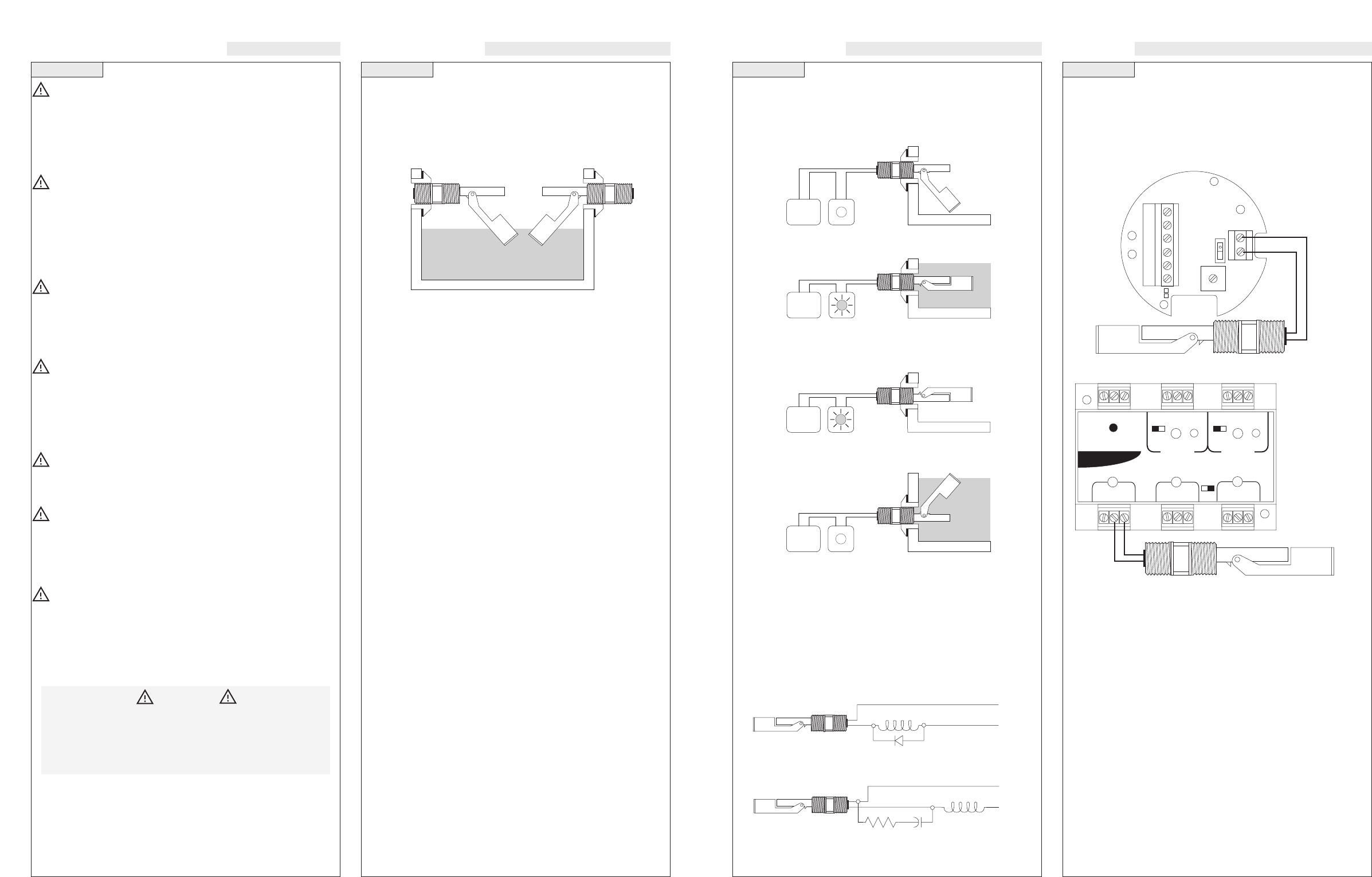
Step Two Step Three
SAFETY PRECAUTIONS INSTALLATION
About this Manual:
PLEASE READ THE ENTIRE MANUAL PRIOR TO
INSTALLING OR USING THIS PRODUCT. This manual
includes information on all models of horizontal mini-float level
switches from OMEGA ENGINEERING, LVH-200 series. Please
refer to the part number located on the switch label to verify the
exact model which you have purchased.
User’s Responsibility for Safety:
OMEGA ENGINEERING manufactures a wide range of liquid
level sensors and technologies. While each of these sensors is
designed to operate in a wide variety of applications, it is the user’s
responsibility to select a sensor model that is appropriate for the
application, install it properly, perform tests of the installed system,
and maintain all components. The failure to do so could result in
property damage or serious injury.
Proper Installation and Handling:
Because this is an electrically operated device, only properly
trained staff should install and/or repair this product. Use a proper
sealant with all installations. Never overtighten the sensor within
the fitting, beyond being hand tight. Always check for leaks prior to
system startup.
Material Compatibility:
The LVH-200 series switch is available in one wetted material.
Models LVH-200 series are made of Polypropylene (PP). Make
sure that the model you have selected is compatible with the appli-
cation liquid. To determine the chemical compatibility between the
sensor and its application liquids, refer to an industry reference
such as the Compass Corrosion Guide (available from Compass
Publications, phone 858-589-9636).
Temperature and Pressure:
The LVH-200 series switch is designed for use in application tem-
peratures up to 107.2 °C, and for use at pressures up to 100 psi.
Wiring and Electrical:
The supply voltage used for the LVH-200 series should never
exceed 120/240 volts AC / 30 volts DC @ 20 VA. CE mark ver-
sions should never exceed 30 Vrms and 42.2 Vpeak or 60 VDC.
Electrical wiring of the sensor should be performed in accordance
with all applicable national, state, and local codes.
Flammable, Explosive and Hazardous Applications:
The LVH-200 seriesshould not be used within flammable or explosive
applications. In hazardous applications, use redundant measurement
and control points, each having a different sensing technology. Refer to
the National Electric Code (NEC) for all applicable installation require-
ments in hazardous locations.
Through Wall Installation:
OMEGAENGINEERING’s LVH-200 series sensors may be installed
through the side wall of a tank. The LVH-200 series has dual male
1/2" NPT threads for installation from the outside of the tank in or the
inside of the tank out. If the LVH-200 series is installed in the
Outside-In method, then the outer threads may be used for connection
WARNING
Orientation of the switch is critical. Make sure the switch is
positioned correctly.
Avoid installing the LVH-200 series switch in ferromagnetic
tanks. Doing so will activate the internal reed switch.
to conduit.
Maintenance:
The LVH-200 series sensor itself requires no periodic maintenance
except cleaning as required. It is the responsibility of the user to deter-
mine the appropriate maintenance schedule, based on the specific
characteristics of the application liquids.
Cleaning Procedure:
1. Power: Make Sure that all power to the sensor, controller and/or
power supply is completely disconnected.
2. Sensor Removal: In all through-wall installations, make sure
that the tank is drained well below the sensor prior to removal.
Carefully, remove the sensor from the installation.
3. Cleaning the Sensor: Use a soft bristle brush and mild deter-
gent, carefully wash the LVH-200 series sensor. Do not use harsh
abrasives such as steel wool or sandpaper, which might damage
the surface sensor. Do not use incompatible solvents which may
damage the sensor's Polypropylene plastic body.
4. Sensor Installation: Follow the appropriate steps of installa-
tion as outlined in the installation section of this manual.
Step Four Step Five
ELECTRICAL WIRING
Signal Outputs (Reed Switch):
Normally Open Operation: Orientate the switch such that float swings
down when the switch is dry. In the dry state, the float rests in the
lowest position and the circuit is open.
As the switch becomes wet, the float becomes buoyant and circuit
closes.
Normally Closed Operation: Orientate the switch such that float rests
on top of the switch when the switch is dry. In the dry state, the float
rests on the switch and the circuit is closed.
As the switch becomes wet, the float becomes buoyant and circuit
opens.
Contact Protection (Reed Switch):
When current is interrupted, the inductance of the load generates a
high frequency voltage, which appears across the switch contacts. If
the voltage is large enough, it can cause arcing. Arcing can cause the
contacts to weld to each other resulting in unreliable switching per-
formance. It is essential to protect the circuit, by suppressing the volt-
age to prevent arcing.
This can be accomplished through the use of a diode for DC circuits
and a resistor-capacitor network for AC circuits.
DC Contact Protection:
AC Contact Protection:
Wiring to a OMEGA ENGINEERING Controller:
OMEGA ENGINEERING controllers have a built-in 13.5 VDC
power supply which provides power to all of OMEGA
ENGINEERING's level switches. Alternative controllers and power
supplies may also be used with the LVH-200 series switch.
LVCN-100 Series Controller
LVCN-120/-130/-140 Series Controller
Note: The above wiring is for NO operation. For NC operation, rotate
the switch 180 degrees.
Power
Supply
(+)
(-)
INVERT +/-
IN
P
U
T 1
DELAY
AC
AC
GND
NC
C
NO
R
P
115 VAC
220 VAC
+
RELAY 1 RELAY 2
POWER
INVERT INVERT DELAY
--
+
--
DELAY
INPUT1 INPUT2A INPUT2B
ONOFF
LA
TCH
Power
Supply
Inductive Load
1N4004
Pos
Neg
Inductive Load
100Ω
1/4 watt
.1 F
.600 V
HOT
NTRL
Power
Supply
Power
Supply




